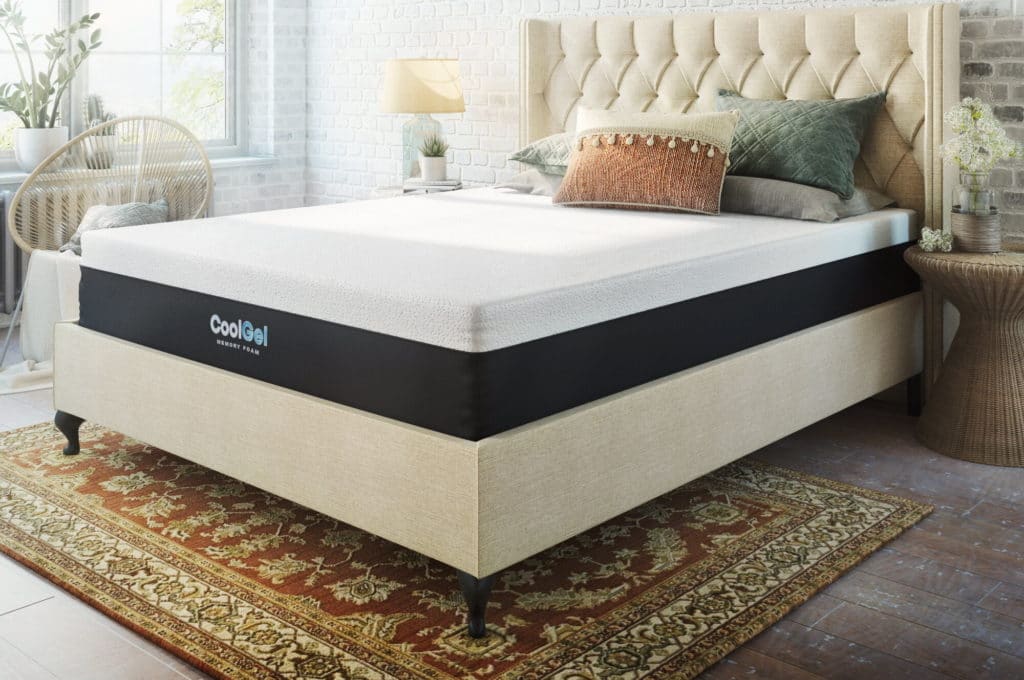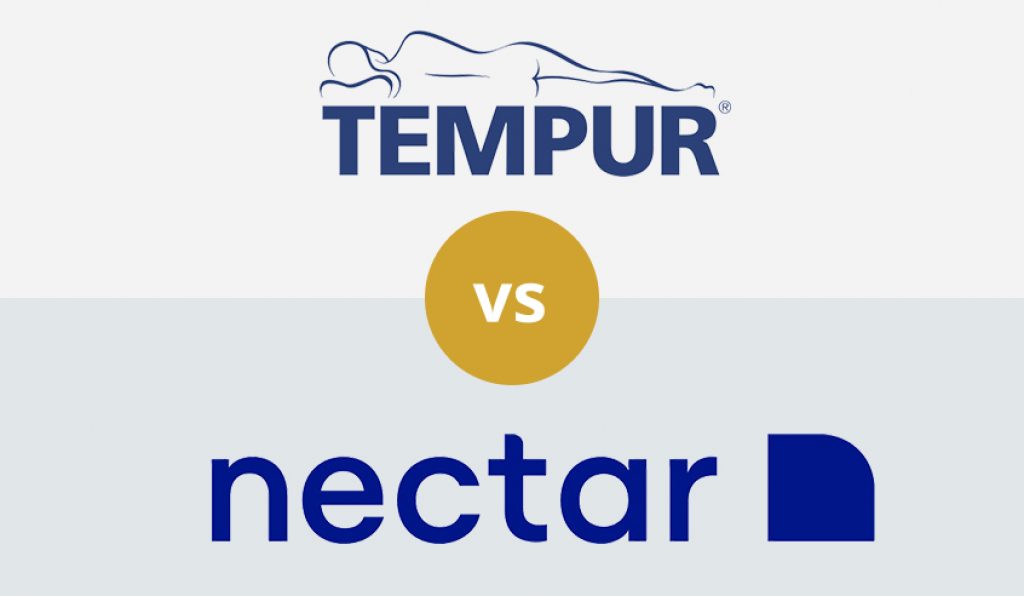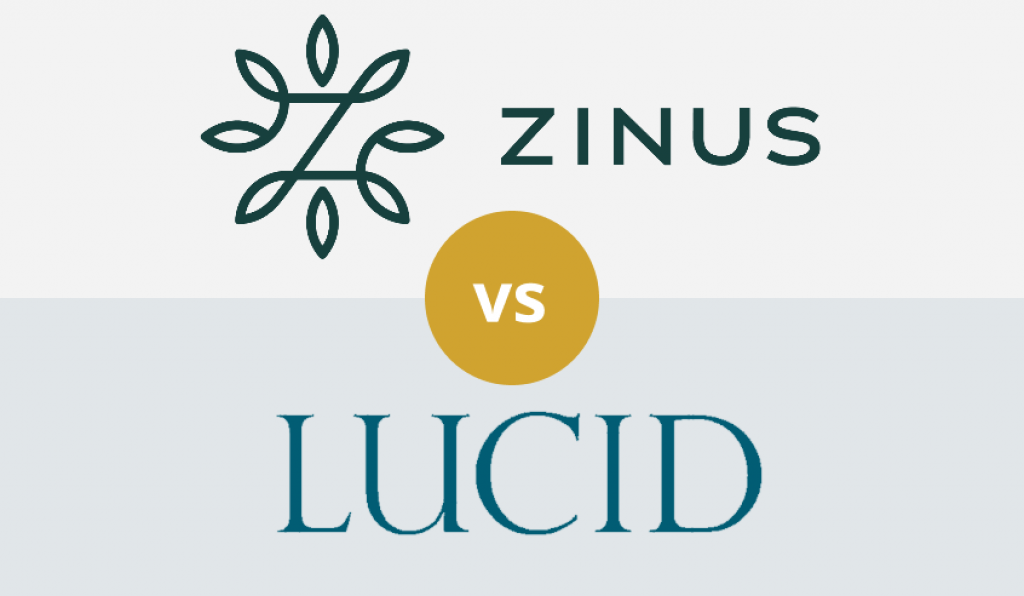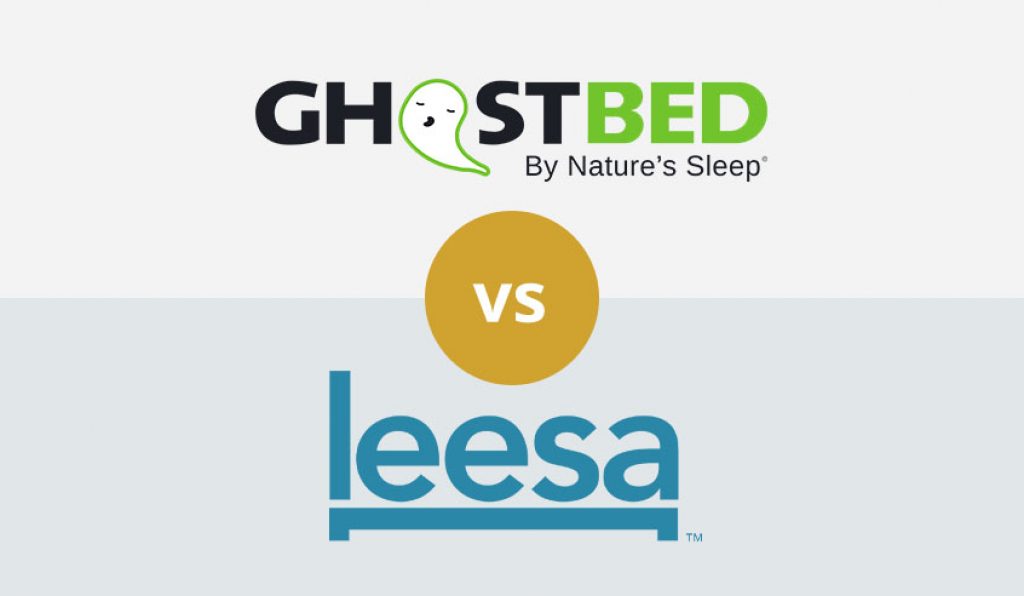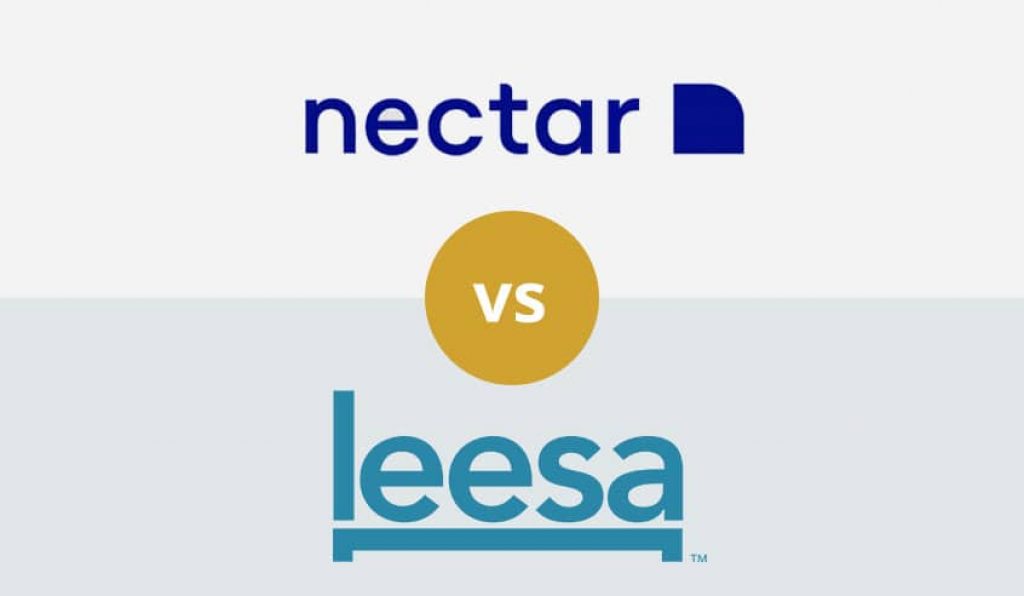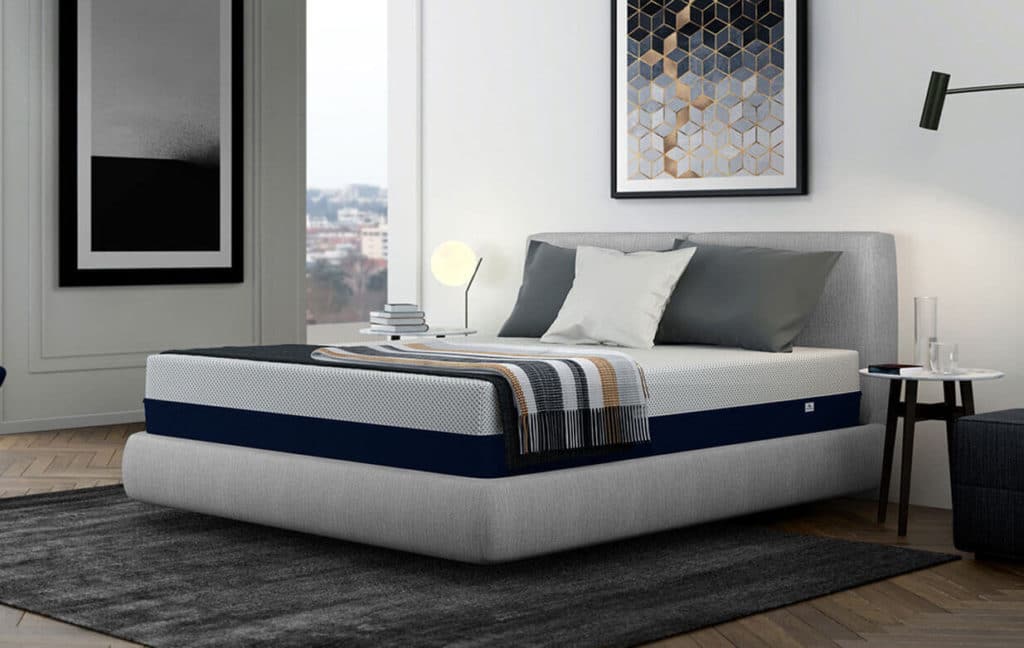

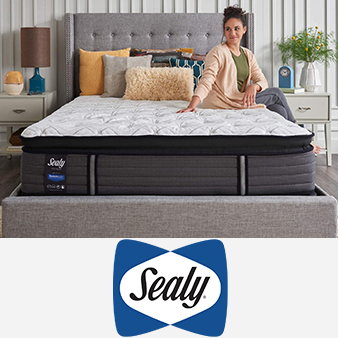
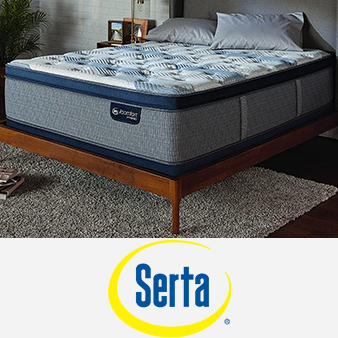
When it comes to getting a good night’s sleep, the names Sealy and Serta stand out. These two mattress brands both produce high-quality hybrid beds that won’t break the bank. They’re each rated very highly by a wide variety of sleepers, too, so their beds promise to improve your rest no matter your favorite sleeping position. In this guide, we’ll compare the Sealy vs. Serta bed head-to-head to help you determine which of these mattresses is the best option for you.
The Sealy and Serta mattresses are both hybrid mattresses that combine foam comfort layers with an innerspring support core. However, that’s about where the similarities between these two mattresses end.
The Sealy mattress is built with different layers of foam, each of which offer a different level of support. On top, there is three inches of soft foam that allows you to sink into the mattress slightly. That, combined with another one-inch layer of gel-infused memory foam underneath, gives this mattress a soft feel that many side sleepers love.
The Serta mattress is slightly firmer, although not by much. It has an extremely plush, but relatively thin layer of cooling gel foam on top of two layers of memory foam. Two more layers of traditional foam add a bit more firmness, but there’s about ½-inch less foam on this mattress than on the Sealy bed. So, you’ll feel the support from the innersprings a bit more.
The price points of these two mattresses are also quite different. A queen-sized Sealy bed retails for under $800, while a Serta mattress costs closer to $1,400. Serta does offer a 120-night sleep trial instead of a 100-night trial, but the difference in cost can be very significant depending on your budget.
| Sealy | Serta |
|
|
| VIEW ON AMAZON | VIEW ON AMAZON |
| Sealy | Serta | |
| Type | Hybrid | Hybrid |
| Firmness | Medium-soft | Medium |
| Thickness | 14.5″ | 14.25″ |
| Weight | 77 lbs | 75 lbs |
| Sleep trial | 100-night | 120-night |
| Warranty | 10-year limited | 10-year limited |
| Price (Queen) | $776.79 | $1,395 |
| Certification | CertiPUR-US | CertiPUR-US |
| Sealy | Serta | |
| Support core | 8.5″ encased coils | 3-stage coil support system |
| Comfort layers | 3″ extra-soft foam1″ gel memory foam 2″ air foam |
1″ EverCool Fuze gel foam 3/4″ TempActiv gel memory foam 2″ EverCool Fuze gel memory foam 1/2″ Serta Pillowsoft foam 1-1/4″ Serta Pillowsoft HD foam |
| Cover | Knit fabric with Moistureprotect and Allergenprotect technologies | TempActive fabric cover |
Both the Sealy and Serta mattresses are hybrid beds, meaning that they use foam for the comfort layers but have an innerspring coil support core. The coil layer in both beds are more than eight inches thick, so there is plenty of support no matter your weight or sleeping style. Serta uses a proprietary three-stage coil support system, although this doesn’t differ much from Sealy’s standard individually encased coils.
The foam layers in the two mattresses are quite different. Sealy has a three-inch layer of extra-soft foam on top, which gives the mattress an extremely plush feel. Underneath that, a one-inch layer of gel memory foam and a two-inch layer of air foam promote heat dissipation and help transition your body onto the innerspring support core.
The Serta mattress uses fully five different layers of foam. The first three layers, totaling 3 ¾ inches, are pretty soft, although not quite as plush as the extra-soft foam in the Sealy bed. Blow that, Serta’s proprietary Pillowsoft foam comes in two densities to help transition you gently onto the innerspring core.
Both of these beds come with cooling knit fabric covers. The Sealy cover is designed to move moisture away from your body as well as to prevent allergens like dust from accumulating inside the mattress. The Serta fabric cover serves a similar purpose and has additional cooling properties to keep you from overheating during the night.
When choosing the right mattress for you, comfort is everything. To help you decide which of these two beds will be better for your sleep, we’ll take a closer look at key aspects of comfort and break down how the Sealy and Serta mattresses differ.
Both the Sealy and Serta mattresses are relatively plush. The Sealy bed is rated as medium-soft, while the Serta mattress is rated as medium. However, side and back sleepers tend to favor each of these beds significantly more than stomach sleepers do.
The reason the Sealy mattress rates as medium-soft is the three-inch layer of extra-soft foam. It doesn’t leave you feeling like you’re slowly sinking into the mattress, since it’s not memory foam. Instead, it’s more like an extremely plush pillow top. The one-inch layer of gel memory foam adds a little sinking, but it serves more to eliminate pressure points as you push down on the support core than to affect the overall feel of the bed.
The combination of foam layers in the Serta mattress is slightly firmer, if not by all that much. The memory foam inside is more noticeable, though, and there is a feeling of the bed conforming around your body as you lie down. For side and back sleepers, that can be an advantage as the foam fills in the hollows created around your hips and lower back.
As far as foam mattresses go, the Sealy and Serta beds sleep relatively cool. That’s in large part thanks to the fact that neither of these beds envelops you with memory foam when you lie down.
However, both mattress manufacturers also went to great lengths to ensure that the foam is as cooling as possible. All of the memory foam used in both beds, for example, is infused with gel to promote heat dissipation. The knitted covers are also designed to help move heat away from your body and to prevent sweating.
On the whole, it’s hard to say that either mattress is better than the other when it comes to temperature regulation. Both are very good in this respect, even if the foam can feel overly warm during hot summer nights.
When it comes to motion transfer, the Serta bed is slightly better at isolating vibrations. Although the foam comfort layers are slightly less thick, much more of it is motion-dampening memory foam. That’s a big help if you have a partner who gets up or rolls around in the middle of the night.
The Sealy bed is by no means bad at motion transfer. However, the extra-soft foam layer does allow for more vibrations than the memory foam used in the Serta bed.
The Serta bed is also slightly more responsive. Although that’s a somewhat unusual thing to say about a mattress with a memory foam comfort layer, the Fuze gel foam on the top of the bed is significantly faster to respond than the pillowtop of the Sealy bed. Your body is also slightly closer to the innerspring coils in the Serta mattress, since the foam layers are half an inch thinner than in the Sealy bed.
Neither of these beds are particularly bouncy, since any momentum is quickly extinguished by the foam layers before your weight compresses the innersprings below. However, the Serta has a slight edge in this respect since the foam layers are slightly less thick. The upper foam layers are also more resilient over the long term than the extra-soft foam used in the Sealy bed. However, this is an advantage mainly by comparison – gel-infused foams are not particularly resilient compared to more firm foam styles.
Edge support on both the Sealy and Serta mattresses is surprisingly good. You may sink into the bed slightly, but the innerspring support core won’t collapse under your weight as you move towards the edge of the bed. The Sealy mattress is actually better for sitting on the edge, since the extra-soft foam draws you back into the bed when it compresses rather than dumping you out of the bed.
Since these beds are hybrid mattresses, they require almost no inflation time. Just unbox them and the springs will snap into place. The foam in each mattress does require a few days to completely off-gas, but most users found the smell was too faint to notice.
| SLEEP POSITION | Light sleepers(less than 130 lbs) | Average sleepers(130 lbs to 230 lbs) | Heavy sleepers(greater than 230 lbs) |
| Sealy | |||
| Side | Very good | Very good | Good |
| Back | Very good | Very good | Good |
| Stomach | Good | Good | Fair |
| Serta | |||
| Side | Very good | Very good | Good |
| Back | Very good | Very good | Good |
| Stomach | Fair | Fair | Fair |
Both the Serta and Sealy mattresses are fairly soft, so it’s unsurprising that they’re rated most highly by side and back sleepers. Heavy sleepers may find that the mattresses feel too soft, although the innerspring support cores help with this somewhat. The main difference in sleeper ratings is among stomach sleepers, who tend to prefer the pillowtop feel of the Sealy mattress over the memory foam feel of the Serta mattress.
| SIZE | Sealy | Serta |
| Twin | $806.65 | $1,059 |
| Twin XL | $999 | $1,149 |
| Full | $979 | $1,319 |
| Queen | $1,029 | $1,395 |
| King | $1,249 | $1,999 |
| California King | $1,099.99 | $1,889 |
| Split CA King | N/A | N/A |
| Sleep trial | Warranty and refund | Delivery | |
| Sealy | 100-night | 10-year limited warranty | All 48 contiguous states |
| Serta | 120 nights | 10-year limited warranty | Free White Glove delivery to contiguous U.S. |
Sealy and Serta both provide excellent sleep trials. Sealy’s is 100 nights, while Serta’s is 120 nights. However, delivery is very different. Sealy will ship your mattress to your home in a box for you to carry and unpack yourself. Serta, on the other hand, offers a free white-glove delivery service. That’s a big help if you don’t have a partner to help you carry your mattress to your bedroom.
Both companies also offer 10-year limited warranties. However, Sealy is notorious for not honoring its warranty against divots in the foam unless they are deeper than three inches. That’s a big issue, since your mattress can cause back and hip pain with a much shallower sag.
VIEW ON AMAZON [wpsm_pros]
[/wpsm_pros][wpsm_cons]
[/wpsm_cons]
VIEW ON AMAZON [wpsm_pros]
[/wpsm_pros][wpsm_cons]
[/wpsm_cons]
In comparing the Serta vs. Sealy mattresses, there’s a lot to like about both beds. The Serta mattress offers the support of memory foam without the sinking feeling, while the Sealy bed has a soft and comfortable pillowtop feel. Ultimately, which bed is right for you comes down to your budget and what comfort factors – like motion isolation or edge support – are most important to you.
